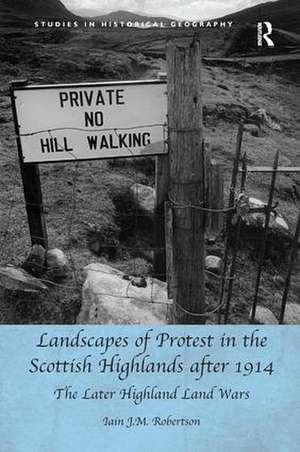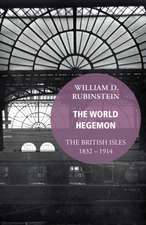Landscapes of Protest in the Scottish Highlands after 1914: The Later Highland Land Wars
Autor Iain J.M. Robertsonen Limba Engleză Paperback – 17 noi 2016
| Toate formatele și edițiile | Preț | Express |
|---|---|---|
| Paperback (1) | 469.34 lei 6-8 săpt. | |
| Taylor & Francis – 17 noi 2016 | 469.34 lei 6-8 săpt. | |
| Hardback (1) | 1058.38 lei 6-8 săpt. | |
| Taylor & Francis – 13 noi 2013 | 1058.38 lei 6-8 săpt. |
Preț: 469.34 lei
Nou
Puncte Express: 704
Preț estimativ în valută:
89.80€ • 93.77$ • 74.16£
89.80€ • 93.77$ • 74.16£
Carte tipărită la comandă
Livrare economică 15-29 aprilie
Preluare comenzi: 021 569.72.76
Specificații
ISBN-13: 9781138279803
ISBN-10: 1138279803
Pagini: 272
Dimensiuni: 156 x 234 x 14 mm
Greutate: 0.45 kg
Ediția:1
Editura: Taylor & Francis
Colecția Routledge
Locul publicării:Oxford, United Kingdom
ISBN-10: 1138279803
Pagini: 272
Dimensiuni: 156 x 234 x 14 mm
Greutate: 0.45 kg
Ediția:1
Editura: Taylor & Francis
Colecția Routledge
Locul publicării:Oxford, United Kingdom
Notă biografică
Iain Robertson is Senior Lecturer in History at the University of Gloucestershire, UK.
Recenzii
Shortlisted for the Saltire Society Research Book of the Year Award 2014 ’The so-called Later Highland Land Wars" have long awaited systematic analysis. No longer. Robertson’s study transforms our understanding of the causes, form and consequences of agitation over the access to land in the post-1914 Scottish Highlands. Blending conceptual innovation, oral history, and subtle readings of the archive, this is a critical landmark in protest history.’ Carl Griffin, University of Sussex, UK ’Skilfully interrogating rich archival sources, Iain Robertson reveals the extent and significance of rural protest in Highland Scotland after 1914 - protest led by men who, having fought for their country, were now fighting for their land. This is an insightful book about landscape and power, memory and morality, politics and resistance.’ Charles W.J. Withers, University of Edinburgh, UK 'Robertson succeeds admirably in his aim of shedding new light on the geographies, causes, and legacies of the land wars, and the book is a valuable and original contribution to the reinvigorated field of protest studies'. Journal of Historical Geography 'The book is logically structured and well-written ... (its) clear strength lies in its telling of a social history of ordinary people and their everyday experiences of living in the borderlands ... The authors are to be commended for producing a significant contribution to scholarship in border studies, social history, and ethnographic approaches in human geography'. Journal of Historical Geography 'Iain Robertson brings new and intriguing perspectives to bear on the mechanics of land raiding and on the motivation of the people (many of them newly demobilised soldiers) who engaged in it. This he accomplishes, first, by meticulous analysis (founded on extensive archival research) of a whole series of separate raids and, second, by exploring the extent to which agrarian protest in the post-1918 Highlands and Islands conformed, or f
Cuprins
Acknowledgements, Introduction, Part I : The Background, 1. Agrarian Change and Rural Social Protest in Highland Scotland c.1700–1914, 2. Protest Paradigms, Part II: Highland Social Protest After 1914: Detail and Debates, 3. Performing Protest, 4. The Geography of Protest: Regional and Intra-regional Perspectives, 5. Testing the Protest Paradigm, Part III: Protesting Bodies Performing Tasks in Place and Space, 6. Placing and Anatomising Protest, 7. Spacing and Dwelling: Performing Protest’s Tasks in the Crofting Landscape, Conclusions, Bibliography, Index
Descriere
In November 1918, the implementation of agrarian change in the Scottish Highlands threatened another wave of unemployment and eviction for the land-working population, which led to widespread and varied social protest. This book not only offers new insights and a greater understanding of what was happening in the Highlands in this period, but illustrates how a range of forms of protest were used which demand attention, not least for the fact that these events, unlike most of the earlier Land Wars period, were successful. Critically, this book draws on oral testimony, which captures different 'moments' of the same event and, if interwoven with the written archival material as here proposed, can only enrich our understanding.











